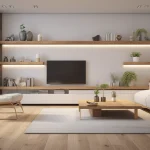
Old homes, rich in history and architectural elegance, frequently call to be conserved and revitalised for modern life. The difficulty is to strike a fine balance between conserving the property’s historical character and providing modern amenities. In this essay, we will look at the art of resurrecting history, specifically how interior designers in Singapore traverse the junction of tradition and contemporary to revitalise historic dwellings.
Respecting Architectural Heritage
The first step in restoring an antique house is to comprehend its architectural style and historical relevance. Interior designers examine the property’s history, including the era in which it was created, the architectural influences at work, and any distinguishing aspects that characterise its character. This understanding serves as the foundation for a preservation strategy that respects the home’s legacy.
Interior designers strive to maintain original characteristics that add to the home’s historical appeal. This might involve repairing ornate mouldings, keeping period-appropriate flooring, and retaining distinctive architectural details. The idea is to honour historical artistry while smoothly incorporating these qualities into a modern environment.
Creating Layouts for Contemporary Living
Old homes frequently include layouts built for a previous era’s lifestyle. Interior designers reinvent space use to meet modern living demands. This might include opening up closed-off rooms, making more fluid transitions between spaces, and optimising places for modern activities such as home offices or open-plan kitchens.
The open-concept living style is a common upgrading method for older properties. Interior designers purposefully remove boundaries to create larger, more linked living spaces. This not only improves the flow of natural light but also creates a sense of airiness and spaciousness that is consistent with contemporary design trends.
Synergy of Old and New
Interior designers are masters at smoothly mixing old and contemporary aspects. This entails incorporating modern furniture and décor into areas with historical aspects. The combination of old and contemporary produces a distinct design harmony, with one piece complementing the other and honouring the home’s progress throughout time.
Contrast is an important architectural idea for revitalising older houses. Interior designers use modern materials and finishes to create a visual separation between old and contemporary components. For example, in a kitchen, combine clean, contemporary counters with historical cabinets or incorporate minimalist lighting fixtures into a space with elaborate ceilings.
Implementing Smart Technology
Interior designers quietly use smart technology to deliver current amenities while maintaining the historical beauty. To retain the space’s authenticity, wiring and equipment may need to be concealed. Smart thermostats, lighting control systems, and covert video equipment are all seamlessly integrated to improve the functioning of older houses.
In kitchens, interior designers like sophisticated gadgets with a classic appearance. These gadgets provide cutting-edge technology while being visually compatible with the space’s historical charm. Smart refrigerators, ovens, and other kitchen appliances are chosen based on their performance and fit with the design story.
Preserving Heritage Colours
Interior designers perform extensive studies to determine period-appropriate colour palettes for older properties. This might include reviewing historical archives, analysing paint residues, and understanding the prevalent colour schemes of the time. The idea is to conserve traditional colours that convey the authenticity of the time while yet appealing to contemporary sensibilities.
While retaining traditional colours, interior designers can alter them to reflect current tastes. This might include reducing the strength of a historical colour or integrating small modifications to keep the palette new and contemporary. The end result is a colour palette that pays respect to the past while embracing contemporary design trends.
Conclusion
Reviving history in historic homes is a delicate skill that necessitates a careful balance of preservation and modernity. Interior designers, equipped with a thorough grasp of architectural history and modern design concepts, traverse this confluence with ease. The ultimate result is a timeless combination of past and present, with the ancient home’s charm retained but upgraded to meet the demands and aesthetics of modern life.








